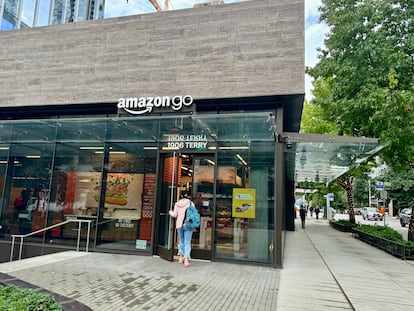Temu, Shein, Miravia: Amazon’s aggressive Chinese e-commerce rivals
These new online retail apps have been fast-tracking their way with all kinds of promotions and big discounts, basing their strategy on significant incentives to buy

As soon as you enter Temu, you are assaulted by a barrage of stimuli. A central banner reminds you that Black Friday is approaching and sets a starting price: there will be products “from €0.39 [$0.42].” At the top, a countdown clock appears, promising free shipping for orders placed before the end of the period. Further down, the platform displays another countdown: in this case, the timeframe is much shorter if you want to take advantage of its flash deals.
Temu is one of the new e-commerce platforms from China; Shein and Miravia are two others. They all share a common style based on a deluge of promotions of all kinds. In this way, they have flooded social media sites with advertisements and have become the talk of influencers within a very short time. Their arrival in the United States and Europe is threatening Amazon’s overwhelming dominance in the e-commerce battle.
Known for selling clothes at low prices, Shein has been a runaway success among young people, who flock to its pop-up stores whenever they open. Moreover, in 2022 it was the third most popular fashion brand among Spanish consumers, behind only Zara and Primark, according to the Fintonic Intent HQ Barometer, prepared by the IESE Business School and the Fintonic expense control app.
The platform has gained popularity through discounts and sales. The same is true of Temu, which arrived in Spain in April 2023; by July, it was already the most downloaded application nationally. In August alone, it had one million downloads, while the second on the list was TikTok, far behind, with 600,000. Shein and Miravia occupied the third and fourth positions, respectively.
According to Jordi Ordóñez, a consultant specializing in e-commerce, the growth of these platforms is quite viral: “They make the strongest inroads by going viral on social media. From there, they take you to the applications, which always have a super-big discount in exchange for registering. And then they bombard you with notifications and discounts,” he explains.
These apps base their strategy on a steady stream of incentives for consumers to buy. They launch expiring offers and hand out discount codes, which are disseminated through social media, including WhatsApp and Telegram groups. For instance, Shein’s interface greets you with “25% off and a free gift,” along with a countdown clock. A simple search on Temu shows discounts of 40%, 45% and up to 85%. At Miravia, you’re greeted with a 20% welcome coupon. That is in addition to their Flash Offers, a showcase of products discounted by 27%, 54% or 74%.
“Everything serves to create a feeling of anxiety to consume and seek immediacy,” says Ordóñez. “There are flash sales, which are fleeting offers that last for 24 or 48 hours, and countdowns, so that you feel pressured to go in now and buy now because otherwise you’ll lose the discount.”
These tactics inspire a sense of urgency in consumers. “It rushes them to go get that deal that they can’t pass up,” says Núria Cónsola, a psychologist who specializes in addictions and is the director of Centre Benavet, in Tarragona, Spain. “They are often impulse purchases, because we don’t need anything; we just want to take advantage of the discount because it seems to us like we have made the purchase of the century.”
A piece of Amazon’s pie
This model’s business costs are high. But there is financial muscle behind these platforms. Temu belongs to Chinese e-commerce giant Pinduoduo, which has over $100 billion in capital. Miravia is owned by Alibaba, which also owns AliExpress and has capital in excess of $200 billion. For its part, Shein has raised over $4.1 billion in rounds of funding and is unofficially valued at $64 billion.
“There are tremendous investments behind capturing market share. At the end of the day, it’s all about luring and attracting a lot of users, getting a lot of sellers on the platform and increasing orders,” explains Ordóñez, adding that the strategy clearly makes financial sense: “If you enter a market like the United States and steal 1% of it from Amazon, that’s millions and millions [of dollars].”

And Amazon has already started to feel the pinch in some areas. According to the analytics website Statista, in the United States, Amazon’s unique visitors fell by 17 million to 211 million between December 2022 and March 2023. In the same period, Temu went from 44.5 million unique visitors to 70.5 million, while Shein gained 6 million visitors for a total of 41 million. According to the Global Wireless Solutions consultancy, in the UK, Amazon lost 1 million cellphone users in the first six months of the year, falling to 8.3 million. Meanwhile, Shein doubled its cellphone users to 2 million. And, after its April arrival, Temu reached 3.5 million users on its app in just one month.
Growth based on aggressive offers
These online marketplaces have based their rapid rise on promotions. However, Cónsola says that this type of sales strategy encourages impulse and compulsive buying among users. The former refers to buying something impulsively and the latter implies reiterative consumption. “When a purchase is impulsive or compulsive, what produces pleasure is the fact of having won the prize, which is a big discount. What you buy is the least important thing,” the psychologist says. “The brain generates the segregation of dopamine, which is the neurotransmitter of pleasure, and we feel happy. But this happiness is very short-lived.” She adds that the best feeling occurs at the moment of purchase, not when one receives the package.
According to Ordóñez, these tactics come from the Chinese market, where consumers want everything immediately and buy a lot from their cell phones. “They are trying to export this formula and it is working very well,” he stresses. However, he warns about the formula’s future, given the high costs of the business model.
Cónsola describes the model’s tactics as “dangerous.” Why? “It’s very similar to how gambling works. It’s made-up, but at bottom the purpose is the same as in gambling: to win something. And when we want to win, depending on [our] personality type and how much control [we] have over [ourselves], we’re going to try again and again,” she stresses.
Some sales gimmicks don’t even bother to hide this similarity. At Shein, there is a games icon as soon as you enter. Clicking on it brings up a panel with prizes, as seen in a video broadcasting a recent campaign, and you can use virtual coins to tap on a button and, after a stimulating beep, you find out which discount coupon you get. It all has a whiff of the casino about it, and it includes a suggestive final message: “Play again.”
Sign up for our weekly newsletter to get more English-language news coverage from EL PAÍS USA Edition
Tu suscripción se está usando en otro dispositivo
¿Quieres añadir otro usuario a tu suscripción?
Si continúas leyendo en este dispositivo, no se podrá leer en el otro.
FlechaTu suscripción se está usando en otro dispositivo y solo puedes acceder a EL PAÍS desde un dispositivo a la vez.
Si quieres compartir tu cuenta, cambia tu suscripción a la modalidad Premium, así podrás añadir otro usuario. Cada uno accederá con su propia cuenta de email, lo que os permitirá personalizar vuestra experiencia en EL PAÍS.
¿Tienes una suscripción de empresa? Accede aquí para contratar más cuentas.
En el caso de no saber quién está usando tu cuenta, te recomendamos cambiar tu contraseña aquí.
Si decides continuar compartiendo tu cuenta, este mensaje se mostrará en tu dispositivo y en el de la otra persona que está usando tu cuenta de forma indefinida, afectando a tu experiencia de lectura. Puedes consultar aquí los términos y condiciones de la suscripción digital.










































